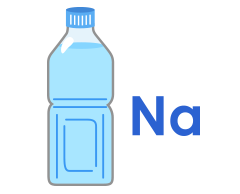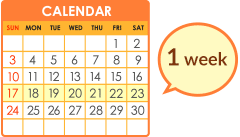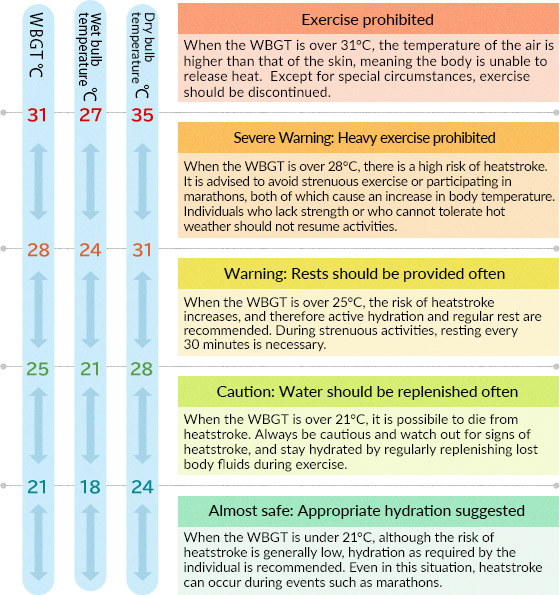Heat disorders in sports: preventive measures
Causes of heat disorders during sports include the individual's physical condition, the environment, and the exercise. If even just one of these is out of balance, heat disorders can occur.
When it is hot, the body's strength reserves become depleted more quickly; although the body may seem to be working harder, the training is not more effective than it would be in regular conditions. Not only for the sake of preventing heat disorders, but also from the standpoint of training efficiency, it's vital that a rehydration plan is integrated into the exercise schedule. In addition, the physical condition of each and every student should be assessed, and the manager or trainer should provide adequate guidance and oversight, managing the intensity of the exercise depending on the temperature.
Factors that contribute to heat disorders
- Temperature
- Humidity and direct sunlight
- Presence or absence of wind
- Onset of a heat wave
- Individual differences in strength and physical constitution
- General Health condition
- The person's physical health and level of fatigue
- The degree to which the person is acclimated to the heat
- Clothing etc.
- Intensity, nature, and duration of exercise
- Rehydration
- Rest break regimen
Source:
Ministry of Education, Culture, Sports, Science and Technology, Japan Sport Council. "Heat Disorders- Knowledge and Prevention" (partially modified)
Be careful about the environmental conditions in which you exercise

Try to choose cool times of the day to exercise during the hot season. Also, avoid exercising for long periods and take plenty of breaks (at least once every 30 minutes).
Make sure to rehydrate

When you sweat profusely, make sure to supply salt (sodium), not only water.
Beverages recommended by the Japan Sport Association
- 1Chilled to between 5℃ and 15℃.
- 2Easy to drink
- 3A composition and quantity that will not remain in the stomach for a long time
Beverages that are effective for rehydrating are those that contain sugar and 0.1% to 0.2% of table salt (40mg to 80mg of sodium per 100mL). Beverages containing 4% to 8% sugar should be drunk when exercising for 1 hour or longer.
It is ideal if you can replace the amount of fluid lost through sweat. By weighing yourself before and after exercising, you can see how much fluid you have lost from sweating.
Acclimatize to the heat gradually

It takes about a week to acclimatize to hot weather. Moreover, the higher the intensity of the exercise, the more heat is produced, increasing the risk of heat stroke. Avoid heavy exercise when your body is not used to the heat and acclimatize gradually by starting with light exercise for short periods. This is also true when you have not exercised for a while.
Dress as lightly as possible and avoid direct sunlight

When it is hot, choose absorbent materials and clothing with good ventilation. When exercising under direct sunlight, wear a cap to keep your head cool.
People with a low tolerance for heat need to be especially careful

People with a low tolerance for heat are especially disposed to heat stroke and so should avoid overdoing exercise. In particular, people who are overweight or obese need to be careful as they account for 70% of the accidents related to heat stroke.
If you don't feel well, tell someone immediately and stop exercising

If you feel even a little unwell, let the people around you know and stop exercising. Coaches and instructors should closely monitor how tired players are, and stop exercise or take emergency measures at the first sign of any changes in appearance.
Care is especially needed with running and repeated sprints, which have been reported to cause heat stroke. Early detection and an early response are extremely important for preventing heat stroke from becoming serious.

Source: Guidebook for the Prevention of Heat Stroke During Sports Activities, Japan Sport Association
- Avoid having students exercise, play sports, or work for long periods in direct sunlight
- When exercising, playing sports, or working outside, make sure students wear caps and the lightest clothing possible
- Whether indoors or outdoors, during long practice sessions or work, have students replace fluid and salt (sodium) frequently and take suitable breaks
- Always observe the students' health and pay attention to health management for students
- Always strive to be aware of students' skills, physical condition, and level of fatigue
- Students should develop a habit of informing an instructor if they feel physically or mentally unwell, and to rest if they do feel bad
A Guidebook for the Prevention of Heat Disorders During Sports Activities may be downloaded from the following site.
- Heat disorders in sports - preventive measures
- Heat disorders in the workplace - preventive measures
- Heat disorders indoors - preventive measures






